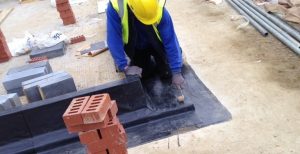It is A High performance barrier for new buildings
High Density Water Barrier: Explained
This form of damp proofing is mainly applied to the walls and floors of buildings which are under construction and are below ground. It is used to prevent lateral damp penetration which is under hygroscopic pressure. In technical terms, applying a High Density Water barrier is a method of damp proofing carried out using a high density polyethylene sheeting material which is coated with a membrane of BS 8102 standards. It is then coated again with a bitumen, rubber self-adhesive layer and a removable reinforced silicone paper. A special primer is also used to ensure adhesion in the correct place. This method of damp proofing is typically used on any internal or external floors and walls and against retaining walls. It works because the complex membrane actively repels moisture, and limits the movement of the structure.
Dealing with penetrating damp
If not thoroughly dealt with using the correct materials, penetrating damp can cause extreme problems not only for the new owner but also for the developer. Without doubt the easiest and most economical way of preventing this is to incorporate the membrane into the build, wherever it is required, whilst the property is under construction. Ideally this would have been included in the architect’s specification and schedule of works. Once installed the High Density Water Barrier Membrane will last indefinitely and prevent serious damp problems in the future.
If you require a High Density Water Barrier Membrane to be installed call us for a quotation on 020 8398 6663.
![]()


 Damp Proofing
Damp Proofing Basement Damp Proofing
Basement Damp Proofing Water Damage
Water Damage Condensation Control
Condensation Control Dry Rot Treatment
Dry Rot Treatment WOODWORM & WET ROT
WOODWORM & WET ROT CAVITY Wall Ties
CAVITY Wall Ties Property Maintenance
Property Maintenance Waterproofing And Tanking
Waterproofing And Tanking Structural Repairs
Structural Repairs








